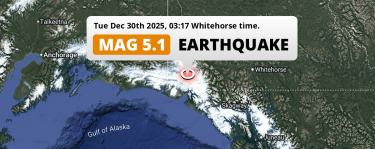Latest earthquakes near Canada today
Complete overview of the latest earthquakes near the country Canada, updated every minute. Did you feel an earthquake today in Canada? If an earthquake is happening right now near Canada, it will show up within minutes.
Recent Canada Earthquake News
These are the latest articles published related to earthquakes occurring near Canada. Check our Earthquake News section for a complete overview of articles written on earthquakes near Canada and elsewhere.
Canada Earthquake Statistics
Average
A total of 402 earthquakes with a magnitude of four or above have struck within 300 km (186 mi) of Canada in the past 10 years. This comes down to a yearly average of 40 earthquakes per year, or 3 per month. On average an earthquake will hit near Canada roughly every 9 days.
A relatively large number of earthquakes occurred near Canada in 2025. A total of 83 earthquakes (mag 4+) were detected within 300 km of Canada that year. The strongest had a 7 magnitude.

Magnitude Distribution
The table below visualizes the distribution of all earthquakes that occurred within 300km of Canada in the past 10 years. No earthquakes with a magnitude of 7 or above have occurred near Canada during this time. Usually, higher magnitudes are less common than lower magnitudes. Small earthquakes with a magnitude below 4 on the Richter scale have been omitted from this overview.
| Magnitude | Earthquakes | Percentage |
|---|---|---|
| Mag. 4 | 353 | 87.81% |
| Mag. 5 | 42 | 10.45% |
| Mag. 6 | 6 | 1.49% |
| Mag. 7 | 1 | 0.25% |
| Mag. 8 | 0 | 0.0% |
| Mag. 9 | 0 | 0.0% |
| Mag. 10 | 0 | 0.0% |
Strongest earthquakes near Canada
The strongest recent earthquake of the past 10 years near Canada occurred on Dec 6, 2025 13:41 local time (America/Whitehorse timezone). It had a magnitude of 7 and struck 250 kilometers (155 mi) west of Whitehorse, at a depth of 5 km. Discover more strong earthquakes near Canada in the list below.
A longer time ago, a MAG-7.8 earthquake struck on Jul 9, 1958 21:15, 292 kilometers (181 mi) west of Whitehorse. It is the strongest earthquake near Canada in the past 126 years (Our data goes back to January 1st, 1900).
In the table below you will find the strongest earthquakes that occurred near Canada in the past 10 years. You can use the tabs to find the heaviest historic earthquakes since the year 1900 or within a specific year or distance from Canada.
Earthquakes by region of Canada
Click the links below for earthquake reports for regions in Canada.
- Alberta
- British Columbia
- Manitoba
- New Brunswick
- Newfoundland and Labrador (Terre-Neuve-et-Labrador)
- Northwest Territories
- Nova Scotia
- Ontario
- Prince Edward Island
- Quebec
- Saskatchewan
- Yukon
Frequently Asked Questions
These questions are commonly asked in relation to earthquakes occurring near Canada.
When was the last earthquake in Canada?
A 2.4 magnitude earthquake hit near Canada on the evening of January 19, 2026 at 18:40 local time (America/Whitehorse). The center of this earthquake was located 262km west-southwest of Whitehorse at a depth of 0km under land. Check the list on our website for any earthquakes occurring near Canada in the past hours.
What was the strongest earthquake near Canada?
A 7.8 magnitude earthquake hit near Canada on the evening of July 9, 1958 at 21:15 local time (America/Whitehorse). The center of this earthquake was located 292km south-southwest of Whitehorse at a depth of 10km under water in the Gulf Of Alaska. This is the strongest earthquake that occurred near Canada since the year 1900.
How often do earthquakes occur near Canada?
In the past 10 years, 402 earthquakes with a magnitude of four or higher occurred within a 300 kilometer range from Canada. This averages to 40 earthquakes yearly, or one earthquake every 9 days.

 Dec 31, 2025 11:55PM
On Wednesday Evening a Shallow M5.3 AFTERSHOCK struck 287km from Whitehorse in Canada.
Dec 31, 2025 11:55PM
On Wednesday Evening a Shallow M5.3 AFTERSHOCK struck 287km from Whitehorse in Canada.
 Dec 31, 2025 11:46PM
Shallow M5.7 Earthquake hit 278km from Whitehorse in Canada on Wednesday Evening.
Dec 31, 2025 11:46PM
Shallow M5.7 Earthquake hit 278km from Whitehorse in Canada on Wednesday Evening.
 Dec 30, 2025 03:17AM
Shallow M5.1 FORESHOCK struck on Tuesday Night 251km from Whitehorse in Canada.
Dec 30, 2025 03:17AM
Shallow M5.1 FORESHOCK struck on Tuesday Night 251km from Whitehorse in Canada.
 Dec 6, 2025 01:41PM
On Saturday Afternoon an Unusually powerful M7.0 Earthquake struck 228mi from Juneau in The United States.
Dec 6, 2025 01:41PM
On Saturday Afternoon an Unusually powerful M7.0 Earthquake struck 228mi from Juneau in The United States.
